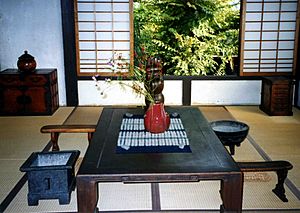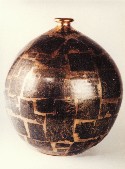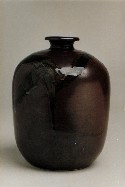Shibui facts for kids
Shibui (渋い) is a Japanese word that describes a special kind of beauty. It's about things that are simple, subtle, and not too flashy. Think of it like a quiet beauty that doesn't shout for attention. Other Japanese ideas like iki and wabi-sabi are similar, and shibui can describe many things, not just art or fashion.
Shibusa is about a rich, calm look or feeling that comes from something well-made. It uses simple shapes, lines, and effort to create a peaceful feeling that lasts a long time.
Here are some key things about shibusa:
- Shibui objects look simple at first. But if you look closer, you'll find small, clever details, like interesting textures. This mix of simple and complex makes them special.
- Because of this balance, you won't get tired of a shibui object. You'll keep finding new meanings and beauty in it over the years.
- Shibusa finds a perfect balance between different ideas. For example, it can be both elegant and a little rough, or both natural and carefully controlled.
When it comes to colors, shibui often uses quiet, calm tones. These are usually colors mixed with gray, which gives them a soft, silvery look. Brown, black, and soft white are popular. Sometimes, a small splash of bright color is added to make things interesting.
What Does Shibui Mean?
It's important not to confuse shibui with wabi or sabi. While many wabi or sabi objects can also be shibui, not all shibui things are wabi or sabi. Wabi or sabi objects might look more rugged or even have intentional flaws to make them seem old or natural. Shibui objects don't have to be imperfect or uneven, though they can be.
There are seven main ideas that make up shibusa. These ideas come from Dr. Soetsu Yanagi, a Japanese expert on beauty and a museum curator. He wrote about them between 1930 and 1940.
The seven elements are:
- Simplicity: This means expressing the main idea of something in a very clear and refined way, creating a calm feeling. It's about elegant things that are not showy.
- Implicity: This allows deep feelings to show through a simple design. It suggests there's more to something than meets the eye, offering new meanings each time you see it.
- Modesty: A shibui person shows excellence by taking time to learn and understand. They are humble and quiet about their own achievements.
- Naturalness: This means things look like they grew or happened on their own, without being forced.
- Everydayness: This idea lifts ordinary, everyday items to a special place. It finds joy in simple things that are useful and not fake or unnecessary. Hiroshi Mizuo says that the best examples of shibusa are often found in crafts – everyday objects made by hand.
- Imperfection: This means finding beauty in things that are not completely perfect. It suggests that a small flaw can make you think and imagine more. As the author Nathaniel Hawthorne wrote, sometimes the charm is "partly in their very imperfection; for this is suggestive and sets the imagination at work."
- Silence: This refers to a feeling of peace and calm, where opposing ideas come together. It's about a quiet understanding and respect for life.
Many people have tried to explain shibui. James A. Michener wrote that it's a Japanese word that means "acerbic good taste," but it's hard to translate. The author Trevanian said that shibumi "has to do with great refinement underlying commonplace appearances." Matthew E. May described it as "Elegant simplicity. Effortless effectiveness. Understated excellence. Beautiful imperfection."
Shibui is like a feeling of beauty that keeps getting better. It's about sensing the "life" behind things, like a quiet beauty mixed with intelligence, love, and joy. You can often feel this when you quietly look at simple, natural things, like a sunrise or a simple pot.
Artists like potters, musicians, and painters often try to add shibui qualities to their work. Sometimes, expert singers or actors are called shibui because they perform beautifully without being over-the-top. Even athletes, like tennis player Roger Federer or hockey player Wayne Gretzky, show shibumi when they play so well it looks easy, helping their team without trying to stand out too much. Shibui, and the deep "life" it represents, can be found in all art and everything around us, including ourselves.
How the Term Shibui Started

The word shibui comes from the Muromachi period (1336–1573) in Japan. Back then, it was shibushi, and it meant a sour or bitter taste, like an unripe persimmon. Shibui still has that meaning today, and it's the opposite of amai (甘い), which means 'sweet'.
But by the start of the Edo period (1615–1868), the word slowly began to describe a pleasing kind of beauty. People in Edo used it to talk about anything from songs to fashion to crafts that were beautiful because they were simple, or exactly what they were meant to be, without extra decorations. So, the idea of shibumi looks for events, performances, people, or objects that are beautiful in a direct and simple way, without being flashy.
The idea of shibusa was first introduced to Western countries in 1960 through the American magazine House Beautiful.




